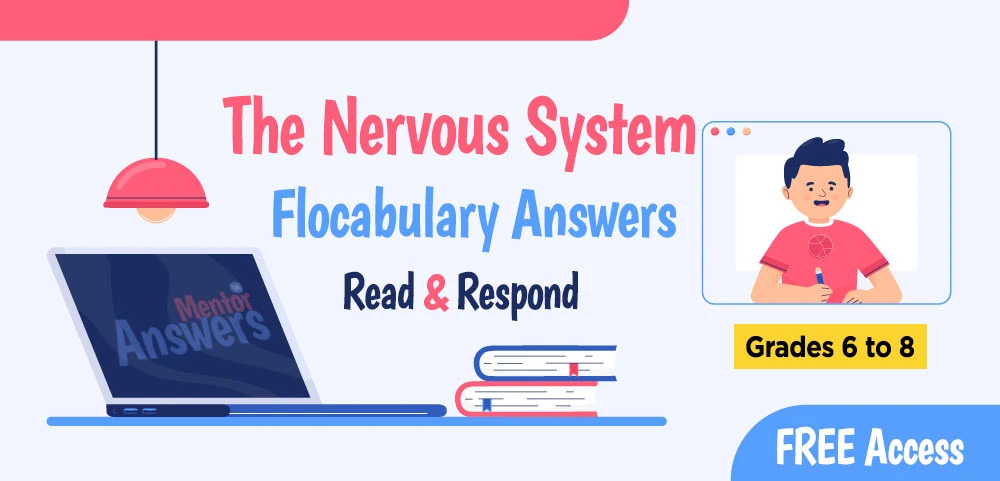Are you looking for a reliable source of answers for The Nervous System Flocabulary Quiz, Read & Respond? You’ve come to the right place!
We have a team of teachers who have checked and verified the correct answers for all the questions. You can trust our expertise and save time by using our answers key.
The Nervous System Flocabulary Quiz Answers Key
- the sympathetic and the parasympathetic
- the active nervous system and the inactive nervous system
- the central nervous system and the peripheral nervous system
- the large nervous system and the small nervous system
- heart, brain and lungs
- spinal cord, nerves and brain
- arteries, veins and blood
- backbone and skull
- rounded structures at the center of most cells that contain genetic material
- organs that control thought, movement, emotion and memory located above a spinal cord
- specialized cells that carry nerve impulses throughout the body
- cords of nervous tissue in the back, inside the backbone
- The peripheral nervous system consists of nerves and neurons throughout the body. The central nervous system consists of the spinal cord and brain.
- The peripheral nervous system is only active when a person is sleeping. The central nervous system is active all the time.
- The peripheral nervous system controls involuntary actions. The central nervous system controls voluntary actions and reflexes.
- The central nervous system consists of the heart and lungs. The peripheral nervous system consists of the spinal cord and brain.
- does not require the brain, spinal cord, nerves or neurons to function
- controls only reflex actions, like moving your hand away from a hot stove
- controls voluntary actions, like running and dancing
- regulates your body’s internal processes, like your heartbeat
- First, neurons carried a message from Eduardo’s legs to his spinal cord. Then, his spinal cord sent it along to the brain to process. Lastly, his brain determined that it was the dog.
- First, neurons carried a message from Eduardo’s legs to his spinal cord. Then, his spinal cord processed the information and determined that it was the dog.
- First, neurons carried a message from Eduardo’s brain to his spinal cord. Then, his spinal cord sent it along to his legs to process. Lastly, his legs determined that it was the dog.
- A single neuron in Eduardo’s leg traveled first to his brain, then to his spinal cord and lastly, back to his leg.
- This was a reflex that the somatic nervous system controlled.
- This was a voluntary action that the somatic nervous system controlled.
- This was an involuntary action that the autonomic nervous system controlled.
- This action was not controlled by the nervous system.
- This was a reflex that the somatic nervous system controlled.
- This was a voluntary action that the somatic nervous system controlled.
- This was an involuntary action that the autonomic nervous system controlled.
- This action was not controlled by the nervous system.
- the somatic nervous system
- the somatic and autonomic nervous systems
- the autonomic nervous system
- This action is not controlled by his nervous system.
- This reaction was not controlled by the nervous system.
- This reaction was only controlled by the central nervous system.
- This reaction was not controlled by neurons.
- This reaction was a reflex.
The Nervous System Flocabulary Read & Respond Answers
Expand your knowledge by exploring the Read & Respond answers related to the topic of our Subject:
- works to make sure you eat only healthy foods.
- is the only system responsible for your breathing.
- sends messages to and from your brain.
- is made up of just the spinal cord and neurons.
- a test tube that holds liquid chemicals in place.
- a hot chili pepper that makes your mouth water.
- an apartment building where many families live.
- telephone wires that carry messages along.
- acts with the central nervous system to coordinate many responses.
- includes the brain and spinal cord.
- is located at the center of the body.
- only interacts with the central nervous system while a person is asleep.
- the hippocampus
- the brainstem
- the cerebellum
- the cerebrum
- waving
- breathing
- clapping
- walking
- are voluntary responses to stimulus.
- don’t require a message from the brain.
- pass sensory information directly to the brain.
- are controlled by the autonomic nervous system.
- It controls the body’s “rest and digest” mode.
- It carries blood throughout the body from the heart.
- It slows down the heart rate.
- It works during “fight or flight” mode.
Are you interested in delving into additional subjects and Lessons related to Flocabulary? Check Here To Get All Flocabulary Answers Key
If you have any questions or need more answers key for your favorite subject, please leave a comment below or contact us through our website. We would love to hear from you and assist you in your learning journey.

